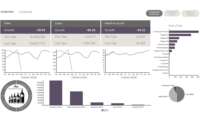How ERP systems help equipment manufacturers reduce lead times

Why would a relatively small business choose to make the significant investment needed to implement an enterprise resource planning (ERP) system? There are many answers to that question, including streamlining engineering processes, improved inventory management, better costing knowledge and more efficient financial reporting. This information is often difficult to extract from legacy manual systems that rarely talk to each other.
Selecting the right ERP system is just the first step. Management commitment is needed for the software, training and implementation time required.
Here’s how implementing an ERP system can reduce an equipment manufacturer’s lead times for building machines and improve its financial reporting.
Getting good sales and cost information can be a challenge
Butler Automatic, Middleborough, Mass., manufactures automatic web splicing equipment for food, pharmaceutical, printing and consumer packaged goods markets. By 2013, it was apparent that it was impossible to get adequate reporting on sales and cost information from Butler’s legacy business system (GrowthPower) on precisely how much it costs to build machines without a lot of time-consuming, manual data manipulation.
After working with a consultant to determine ERP system requirements, Butler interviewed several potential software suppliers and put a contract out to bid. The system had to be a full “quote-to-cash” system, including quoting, order entry, buying, production, service and parts sales. A range of accounting functions was also needed, including an ability to export directly to financial statements. After analyzing the bids, Butler selected Epicor ERP, which contains specific modules focused on reducing costs, streamlining processes and improving customer responsiveness across the enterprise.
Focus on efficient implementation
Butler contracted with ComTec Solutions, Rochester, N.Y., to assist with implementation in 2014; the system went live in 2015. Efficiency was the implementation mantra. The management team wanted to use the software tools to track data, but do so without having to hire a team whose sole job was collecting and entering data.
Implementation did not come cheap. The cost of the hardware, training and software amounted to more than $300,000. In addition, five staff members from different departments within the company (all with another “normal” job) spent an hour a day for 10 months learning the software and preparing for implementation.
“We ran through the process every day to review how it would work,” says Mary Weiser, Butler’s director of finance and administration. “We tweaked it and made adjustments to make it work well in our environment.”
The project implementation team also spent hours preparing old data to import it into the new system, overcoming challenges related to inventory setup and a general lack of familiarity with the data fields.
“We made a decision early on to begin by going live with functions we could already do with the legacy system,” says Weiser. “We wanted to get the new system right and get familiar with it and then add new functions after the entire staff was comfortable. Management’s commitment to make the system work by devoting the necessary time to tailor the system for our needs was the key to success.”
The first few weeks were bumpy, but for the most part, staff quickly settled in and became comfortable with what the system has to offer. Three years ago, Butler’s lead times were 8-12 weeks. Today, they are able to ship a machine 4-6 weeks after receiving the order.
“We have reduced our engineering time by about a week, and we have seen tremendous improvement in our materials/inventory controls, so that we either have what we need to build the machine or can acquire it quickly,” she adds.
Another efficiency gained comes from the system’s ability is to better accommodate different currencies. Butler operates an office in Geneva, Switzerland, that services European customers. The office works in Euros and Swiss francs. In the past, Butler needed to run the European business on QuickBooks, while the U.S. business ran on GrowthPower, which did not support multiple currencies.
This created a lot of work when shipping machines to European customers. Butler could not transfer parts from the United States to Geneva, so inventories were higher, and financially, they had to consolidate at the end of each period. Epicor takes exchange rates into consideration for various currencies and reports everything in U.S. dollars.
Another success is the availability of real-time financial information. The Butler accounting team can now issue preliminary financial statements by noon on the first day of the month, whereas it used to take 4-5 days to prepare statements.
Epicor comes with many standard reports, including a Sales Gross Margin report, which can be run by customer, part or product group, and a Production Detail report, which provides information on material, labor and overhead costs for each job. There are also features that allow the accounting team to export data into Excel and then use all of Excel’s features to compile information. Finally, Epicor enables the team to design reports customized to Butler’s business.
Future modules to focus on manufacturing execution
Butler is considering several other modules, in particular a manufacturing execution system (MES), a control system for managing and monitoring work-in-process on a factory floor. The MES will automatically collect information from production machinery to provide an accurate picture of what’s going on in the plant and where improvements can be made. From scrap and downtime analysis to automatic part qualification and rejection, Butler hopes to use the MES data to get the whole story of production in the manufacturing environment.
ERP takes a full management commitment
Implementing an ERP system is a major undertaking for a small business. It takes a full commitment by the management team because people are generally reluctant to change. Encouragement and perseverance is needed to see the implementation through to completion, but it is well worth the effort. The right ERP system brings efficiency benefits and provides valuable real-time information to make the best decisions. It also helps Butler keep up with the latest management techniques to meet customer demands for fast turnaround times.
Looking for a reprint of this article?
From high-res PDFs to custom plaques, order your copy today!






